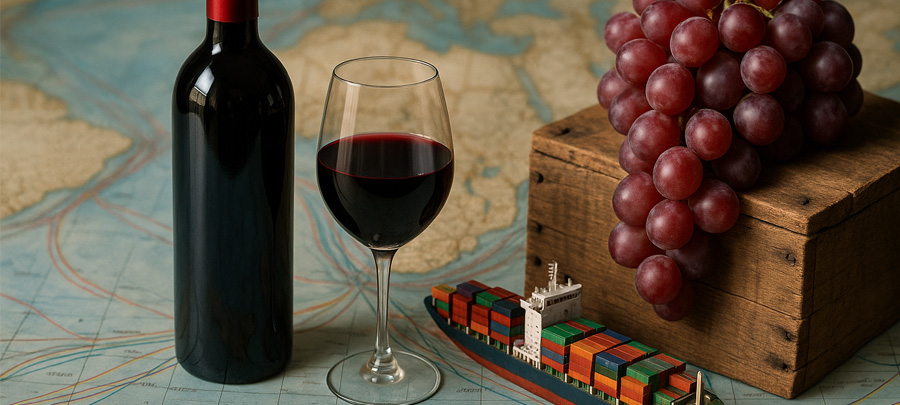

The global wine trade has entered 2025 under complex pressures—balancing continued premiumisation with geopolitical uncertainty, shifting consumer channels, and evolving tariff regimes. For wine producers and wineries aiming to grow or defend their international market presence, understanding the real-time dynamics of wine imports is more critical than ever.
In this mid-year review, we analyze verified import data from the first half of 2025 across key markets, including the United States, EU, and emerging regions. With a focus on volume trends, pricing shifts, and policy developments—particularly U.S.–EU trade tensions—this article offers actionable insights to help industry stakeholders navigate a rapidly evolving landscape. Whether you’re an export-focused winery or a regional producer monitoring foreign competition, the data and strategic recommendations presented here will inform better planning and smarter decisions for the second half of the year.
1. Global trade stagnates, but premiums prevail
- The average export price for wine rose to €3.60/L (up 30% since 2020), reflecting continued premiumisation even as bulk volumes softened
2. U.S. imports drive growth—but tariff fog looms
Q1 2025: U.S. imported 328.5 million L (+3.9% YoY), valued at €1.748 billion (+21.6%)—average price €5.32/L, up €0.78 versus Q1 2024
Volume gain: +12.2 million L; value gain: +€310.2 million
Major suppliers for the U.S. wine market:
- France: €723.9 M (+51%); 52.4 M L (+37%)
- Italy: 93.1 M L (+16.6%); +17% by value
- Spain: 17.4 M L (+15%); €88.5 M (+8%)
EU tariffs: A 10% tariff commenced April 5; a proposed 20% “reciprocal” tariff was paused mid-April, currently valid through July 9, 2025
3. Why imports surged — and what’s next
- U.S. buyers front‑loaded purchases ahead of tariff escalation, with imports up 8.6% in Q1 2025—evidence of strategic stockpiling
- Domestic winemakers see opportunity: higher priced imports improve relative competitiveness of local wines (e.g., US glass manufacturers facing tariffs adding US $0.50–$1/bottle)
- After two years of decline, total U.S. shipments (domestic + imports) rose in Q1 2025 — from 127.3 M cases (Feb 2024) to 134.4 M cases (Feb 2025), driven in part by imports
4. Other global import trends
- Russia: Q1 2025 domestic production surged +11.6%, but E.U. imports persisted: €28 M in Feb (up from €25.3 M in Jan), with Italy and Portugal leading
- Subscriptions & DTC: Wine subscription market reached US $12.4 B in 2025, growing ~9.7% CAGR—signaling increasing DTC competition to traditional import channels
In China, early‑2025 customs data revealed a notable rebound: 41 million L of wine imported in January–February, a growth of 11.5% in volume and 54.2% in value year-on-year, propelled by Australian sparkling and high-end varietals Meanwhile, despite a broader dip in consumption, China and Japan remained in the top 10 global wine importers by value, each registering approximately €1.5 billion in 2024—China at €5.21/L, Japan even higher at €6.35/L. This premiumisation underscores the rising appetite in Asia for quality and prestige.
Conversely, the EU is not only a major exporter but also a significant importer within its internal market. January 2025 saw EU agricultural and food imports reach €16 billion (+19% YoY), suggesting elevated costs and potential import substitution. With intra‑EU trade comprising nearly 75% of movement and Brexit-linked trade realignment ongoing, EU-based producers must stay agile — even as external tariffs loom.
Strategic Recommendations for Producers & Wineries
| Area | Insight | Action |
|---|---|---|
| Pricing & premium focus | Premium imports (average >€5/L) are driving value growth even as volumes stall. | Position higher-end wines with strong provenance; consider segmenting by format (bottled vs bulk/sparkling) to exploit value niches. |
| Tariff monitoring & agility | Import prices and volumes have fluctuated amid shifting policy. | Stay alert to July 9 deadline; use hedging or buffer stock strategies; diversify into tariff-friendly markets (e.g., Canada, Asia). |
| Leverage glass cost disruptions | EU bottle/glass tariffs (20%) increase domestic wine’s cost competitiveness. | Highlight “EU-sourced bottle” origin or shift packaging to neutral suppliers; communicate cost transparency to buyers. |
| Capitalize on DTC & subscription channels | Subscription channels are growing rapidly and value‑add driven. | Build DTC offers, curated assortments, digital tastings; partner with subscription platforms for export promotion. |
Forecasts: What H2 2025 Could Hold
-
Tariff clarity by Q3 will be pivotal. If EU‑U.S. negotiations fail by July 9, new tariffs could disrupt momentum.
-
Shift to domestic: U.S. producers could increase share if imports get costlier—especially in the €20+ retail segment.
-
Diversification advantage: Italian, Spanish, and smaller EU players should explore alternative markets (Canada, UK, Asia) with trade deals and rising wine-per-capita consumption.
Conclusion
The first half of 2025 painted a clear picture: import‑driven growth is real, premiumisation continues, and geopolitical risks are shaping B2B strategy. For wineries and producers, actionable paths include sharpening premium positioning, building tariff‑resilient supply chains, and embracing direct‑to‑consumer channels. With H2 2025 presenting both opportunity and risk, flexibility and foresight will define the most successful players. In this context, having access to one of the best tools that help you reach reliable wine importers in 168 countries, the BestWineImporters platform, can prove to be a huge advantage.





